Introduction
GitOps is a collection of best practices applied from the beginning of the development workflow to deployment. Git is already used by developers to store application source code; GitOps extends this practice to an application’s configuration, infrastructure, and operational procedures. All application and infrastructure changes are documented in a source control system and are automatically synchronized with the live environment.
GitOps is a set of deployment practices, whereas DevOps is a paradigm or, to put it another way, a mindset. Their common principles make it easier for teams to integrate the GitOps workflow into existing DevOps techniques. This article covers detailed knowledge of GitOps.
How to Get Started with GitOps
GitOps is a model developed on pre-existing practices:
Git repositories are the change mechanism for application and infrastructure updates in GitOps. Any change to an application or environment is represented as a change in a Git repository, which provides a full audit trail and the ability to roll back at any time.
With GitOps, you can clearly distinguish between CI and CD. GitOps takes over after the artifact is created and applies it to the target cluster. Instead of triggering the CI/CD with a commit to the source code, GitOps uses a commit to the configuration repository as the trigger.
Infrastructure as Code (IaC)
A Git repository serves as the single source of truth for your environments in GitOps. Infrastructure as code (IaC) refers to storing all infrastructure configurations in a version control system as code.
Tracking and Observability
An important GitOps concept is observability, a system property that allows it to be easily observed. It allows you to ensure that the desired state described in the declarative configuration matches the current state.
Immutable Servers (Containerized Infrastructure)
GitOps is frequently used to run Kubernetes application development. It allows you to create development pipelines, deploy applications continuously, provision clusters, and deploy on Kubernetes or container registries. GitOps, on the other hand, can be used in other infrastructure environments.
The Principles of GitOps
Declarative Configuration
Using a declarative format, you can describe how the infrastructure works and the applications that run on top of it. This allows for the traceability of changes made to any environment and any source control system’s rollback, recoverability, and self-healing capabilities.
Version Controlled, Immutable Storage
Immutability, versioning, and versioning history are all supported by declarative descriptions stored in the repository. For example, using Git for the above declarations gives you a single location from which everything for the application is derived. This makes it simple to identify any changes made at any time. Examine all changes in the version control history to ensure that the platform always matches what is described.
Automatic Pull Operations
When you use GitOps, you use software agents that are always running in the cluster, pulling the Git state at regular intervals and comparing it to the live cluster state. This way, you can always tell if the Git version is the same as the live state.
Continuous Reconciliation
Operating in a closed loop ensures that a system’s desired state matches its declared state.
When used with the repository, GitOps software agents can perform various functions, including self-healing. Agents perform QA processes for the workflow and protect against human error or manual intervention during an outage.
Benefits of GitOps
- GitOps manages all Kubernetes updates and features more quickly. By continuously pushing features to updates, businesses can become more agile and respond to customer demands more quickly.
- It is cost-effective because it lowers operational overhead, reduces downtime, and vastly improves productivity.
- It standardizes the workflow from start to finish.
- Improves stability by storing audit logs of cluster changes to validate changes made.
- Continuous automated deployment improves productivity by saving time.
- Improved security due to Git’s powerful correctness and cryptography for tracking and managing changes.
Use Cases of GitOps
The following are some use cases for implementing GitOps to improve the current workflow:
For the deployment of complex static websites made up of markdown files that make site pages easier to edit than raw HTML. It requires a build before it can be published. Alter the images to make them available in different sizes to look good on different devices. For all this, GitOps or even copying the deployment to the web server can be used to build a site or optimize an image.
It is a great fit for product documentation and is commonly used for this purpose because it is text-based and can be created as a markdown.
The changes are then retrieved by a CI tool, which deploys the new version of the documentation. As new changes to the documentation are committed, the deployment stage can upload the most recent version to various platforms.
Tools for GitOps
Listed below are the best tools for GitOps:
How do teams put GitOps into Practice?
There is not just one GitOps platform, plugin, or product. The optimal technique for teams to implement GitOps will differ depending on the particular demands and objectives of the team. Hence there is no universally applicable answer to this subject. However, there are some recommendations on how to begin using GitOps, such as establishing a specific GitOps repository for all team members to share configurations and code, automating the deployment of code changes, and setting up alerts to inform the team when changes take place.
Three essential elements are needed for GitOps:
DevOps **GitOps** = IaC + MRs + CI/CD
As the only true source for infrastructure definitions, GitOps leverages a Git repository. A Git repository is a .git folder in a project that records all changes made to files over time. Git is an open-source version control system for managing code changes. The method known as “Infrastructure as Code” (IaC) involves storing every infrastructure configuration as code. It is possible or unlikely that the desired state will be saved as code (e.g., number of replicas or pods).
Merge Requests (MRs) are the modification method used by GitOps for any updates to the infrastructure. Teams can work together in the MR through reviews and comments, which is also where official approvals happen. A merge acts as an audit log and commits to the main (or trunk) branch.
With a Git workflow and Continuous Integration and Continuous Delivery (CI/CD), GitOps automates infrastructure modifications. When the new code is merged, the CI/CD pipeline changes the environment. The environment converges on the ideal state specified in Git due to GitOps automation, which overwrites any configuration drift caused by mistakes or human changes. While GitLab employs CI/CD pipelines to manage and apply GitOps automation, other types of automation, like definitions operators, are also possible.
IaC Tools vs. GitOps
Server provisioning technologies using infrastructure as code have been around for a while. The idea of maintaining versioned, backed-up, and replicable infrastructure configuration came from these tools.
However, as Kubernetes is almost entirely declarative and uses an immutable container, it is possible to apply some of these ideas to manage both apps and their operating systems.
The GitOps philosophy and associated best practices encompass the capability to control and compare the current state of the infrastructure and applications. By using GitOps, you can test, deploy, rollback, and forward code while keeping a full audit trail. This is achievable due to the immutability of containers and the fact that Kubernetes is almost fully governed through declarative settings.
How GitOps is Different from DevOps
There are some common values and objectives between GitOps and DevOps. DevOps aims to provide a collaborative environment for development and operations teams to work together.
GitOps provides you with the tools and a framework to apply DevOps principles, including collaboration, CI/CD, and version control, to the automation of infrastructure and the deployment of applications. Operations can set up the other necessary components while developers work in the code repositories they are already familiar with.
Conclusion
GitOps empowers developers to manage application infrastructure and configurations on their own. GitOps, as the single source of truth, provides developers with familiar tools that aid in automation and productivity.
Many GitOps supporters believe it is the future of DevOps. GitOps’ cloud-native approach to configuration management makes it more relevant than ever, particularly using Infrastructure as Code.







